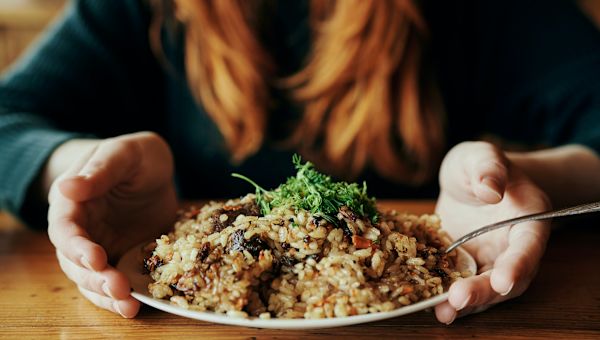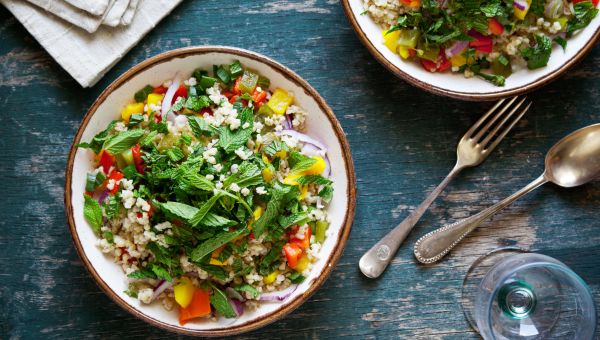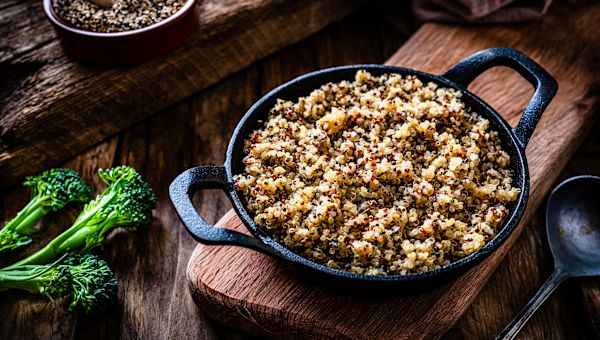4 great whole grains to try today
Swapping out refined grains for these whole grains may help lower your risk of chronic disease.
Updated on June 20, 2025

From amaranth to oatmeal, whole grains are key to a healthy diet. Rich in fiber and numerous vitamins and minerals, they can help reduce your risk of chronic disease by helping to control your weight, blood sugar, and cholesterol levels.
Whole grains are different from refined grains, which include white flour, white bread, and white rice. Refined grains have been stripped of many of their nutrients during processing, and eating too many has been linked to health issues like weight gain and heart disease. Research suggests, however, that swapping in whole grains for refined grains can greatly improve your overall health.
There are many types of whole grains, each with different flavor and nutritional profiles. Here are four to consider next time you go food shopping.

Bulgur
Chewy and slightly nutty flavored, bulgur is a wheat product commonly used in Middle Eastern and Mediterranean cooking, in dishes like tabbouleh and bulgur pilaf. Bulgur is high in fiber and the minerals iron, magnesium, and especially manganese. Manganese supports immune and reproductive system functions, bone building, and the healing of wounds. Bulgur is also a low glycemic-index food, meaning it won’t spike your blood sugar or insulin levels, good news for people with type 2 diabetes.

Barley
One of the first crops to be cultivated by humans, barley has fed millions across the globe for thousands of years. A 1/2 cup of raw pearled or hulled barley delivers about 16 grams of fiber—64 percent of the daily recommended value. The grain is also a good source of protein, as well as a number of vitamins and minerals:
- Selenium
- Manganese
- Magnesium
- Phosphorus
- Vitamin B3 (thiamin)
- Copper
Looking to give barley a try? Try the versatile whole grain in a soup or as a substitute for rice in a risotto.

Quinoa
Though quinoa is really a seed, it’s considered to be a whole grain, nutritionally speaking. Grown largely in South America, this naturally gluten-free whole grain is high in fiber, iron, and potassium, a mineral that helps control blood pressure and is essential to the function of nerves and muscles. It’s also a good source of protein; 1 cup of cooked quinoa contains about 8 grams, about the same amount as a 1/2 cup of black beans. Try quinoa as a replacement for rice in stir fries or burritos, or as part of a savory, spicy quinoa bowl.

Brown Rice
Brown rice is white rice with the nutrient-packed bran layer left intact, which is why it takes a longer time to cook. Though either can be part of a healthy diet, brown rice contains a little more fiber, along with several key minerals, including potassium and manganese. Compared to white rice, studies have linked brown rice to better control of blood sugar, and a lower risk of type 2 diabetes and heart disease. Try brown rice anywhere you would use white rice, or in this zesty, filling salad.

American Heart Association. 7 Whole-Grain Foods You Should Try. June 25, 2024.
Harvard TH Chan School of Public Health. The Nutrition Source: Whole Grains. Accessed June 20, 2025.
USDA MyPlate. Grains. Accessed June 20, 2025.
Oldways Whole Grains Council. What’s a Whole Grain? A Refined Grain? Accessed June 20, 2025.
P NPV, Joye IJ. Dietary Fibre from Whole Grains and Their Benefits on Metabolic Health. Nutrients. 2020 Oct 5;12(10):3045.
Oldways Whole Grains Council. Wheat: July Grain of the Month. Accessed June 20, 2025.
Harvard TH Chan School of Public Health. The Nutrition Source: Manganese. March 2023.
NIH Office of Dietary Supplements. Manganese: Fact Sheet for Consumers. March 22, 2021.
Oldways Whole Grains Council. Barley: February Grain of the Month. Accessed June 20, 2025.
Oldways Whole Grains Council. Quinoa: March Grain of the Month. Accessed June 20, 2025.
HealthDirect (AUS). Potassium and your health. June 2023.
Kazemzadeh M, Safavi SM, et al. Effect of Brown Rice Consumption on Inflammatory Marker and Cardiovascular Risk Factors among Overweight and Obese Non-menopausal Female Adults. Int J Prev Med. 2014 Apr;5(4):478-88.
Ying T, Zheng J, et al. Effects of whole grains on glycemic control: a systematic review and dose-response meta-analysis of prospective cohort studies and randomized controlled trials. Nutr J. 2024 Apr 25;23(1):47.
Harvard Health Publishing. Brown rice versus white rice: A head-to-head comparison. November 8, 2024.
More On


video

article

slideshow


video


video
